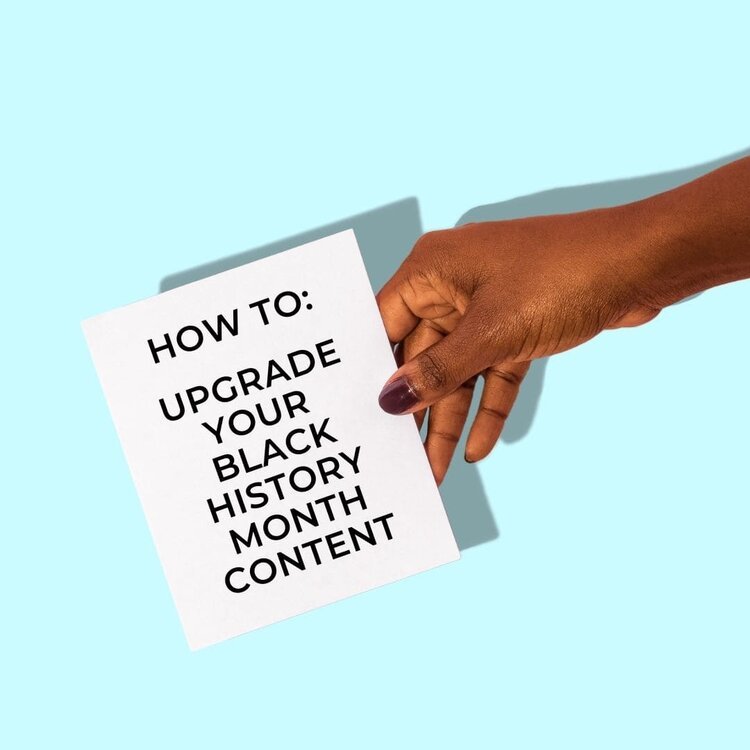4 Ways to Upgrade your Black History Month Content
Well, February’s here and with it the end of dry January and more importantly the start of Black History Month. This means starting today, brands everywhere will be rolling out their Black history content on their social platforms. As an agency focused on helping purpose-driven companies with their Socially Conscious Social, we think it’s our duty...nay our obligation, to help you create a social plan that goes beyond the requisite MLK quote. Because if you’re serious about attracting a more diverse audience it’s essential that you prioritize content that uplifts Black stories, advocates for social change, and educates your audience on REAL American history. And we’re here to help you do just that!
Here are our top 4 tips for brands to ensure their Black history month content isn’t just performative, but actually educates and illuminates the contributions of Black Americans.
Share Unique Stories
The history of Black people is robust and expands far beyond enslavement or Black struggle stories. Instead of depending on the well known civil rights leaders, do some research and highlight little known figures who made a big impact. Bonus points if you find someone in your business’s niche and share their story with the world. For example, if you’re in the food industry, highlighting the Black and African influences in the culinary world, or if you’re a travel agency, sharing the amazing history of the Geechee Gullah people of Charleston, SC. Outside of highlighting unique stories, consider sharing the truth about white-washed or sanitized versions of history to not only help broaden your audience’s knowledge but also to plant seeds that make them question the status quo. You’ll be surprised at just how much of American history has been manipulated to maintain the illusion of white supremacy. You could talk about how the police bombed MOVE, a Black liberation group, in 1985 by literally dropping explosives on the buildings or that Bass Reeves, a man born enslaved, was the inspiration for the “Lone Ranger” whose identity was then erased and white-washed for entertainment purposes.
If we want a more equitable society that recognizes the rights of everyone no matter their background, we need to have more open discussions about our past failings in history, in addition to celebrating our successes, so we can have a better understanding of where we need to go.
Highlight Black Businesses
Did you know that Black businesses with more than 2 employees only make up only 2% of the US population? Only 2%!! Between unequal access to capital and other systemic issues, Black businesses, in particular, took a hard hit during the Covid lockdowns, many closing their doors permanently. If you’re looking to attract a more diverse, inclusive audience, highlighting Black businesses, not for charity, but as a show of solidarity is an important way to take a stand against systemic oppression. This is where really understanding your audience comes in handy. Knowing what your audience is looking for and pointing them in the direction of the Black-owned business that can meet their needs is a great way to show your followers that you’re serious about being an ally. Get creative with IG Takeovers, Facebook Lives, or creating an IG Highlight of the top 10 businesses your audience will love. And do it all without the desire for recognition or monetary compensation.
Call Out Systemic Injustice
This one is for the brands that are ready to draw a line in the sand against white supremacy and systemic oppression. Yes, making racists feel uncomfortable being racist can feel satisfying, but more importantly, it shows your Black followers that your brand is a safe space. Aligning your brand to include social justice opens up a whole new audience base, one that will appreciate your candor. So, how do you do this without risking it all? Well, we know white people aren’t the most open to hearing about race and social justice. When you call out systemic issues you may lose followers and partnerships, which could translate to lost profits. That’s the rub folks. Divesting from white supremacy may cost you, but it may also save lives. So use your voice and your platform to call out injustices. Choose lives over likes and be willing to be the voice of dissension for the greater good. What does this actually look like? Carousel posts educating your audience is a popular way to call out injustice. We also advise leveraging IG stories or reels to highlight these issues and give your followers ways to be part of the solution. That’s what social activism looks like!
Put Your Money Where Your Post Is
Yep...I’m talking about reparations ya’ll. The racial wealth gap is REAL. According to Brookings:
At $171,000, the net worth of a typical white family is nearly ten times greater than that of a Black family ($17,150) in 2016. Gaps in wealth between Black and white households reveal the effects of accumulated inequality and discrimination, as well as differences in power and opportunity that can be traced back to this nation’s inception. The Black-white wealth gap reflects a society that has not and does not afford equality of opportunity to all its citizens.
So brands have an opportunity to use their privilege and access to donate to the causes, people, or businesses to do their part in closing the gap. How? There are a few ways. One is to go beyond Black History Month by making this strategy part of your business year-round. Use a portion of your profits and donate to a cause like Black Lives Matter or NAACP Defense Fund. You can also ask your audience, which is what I did personally for Giving Tuesday and I got some amazing ideas for spreading the social justice love. As an agency, we did this too and were able to donate to 40 different organizations supporting a variety of causes in social justice, local communities, animal rights, mental health, human trafficking, homelessness, and more! A campaign like this is a great way to activate your audience and use their knowledge to help you donate to worthy causes. You may also want to consider a scholarship fund or mentorship for Black students interested in studying your business’ industry. Systemically Black students are less likely to land life-changing mentorships. Your brand can stand in the gap and be an agent of generational change for students who may need a hand up.
In closing, it’s important to note that Black history is American history and should be taught and celebrated throughout the year. Though this country was built on the backs of enslaved Africans, that is not where our history starts or ends. Make a commitment as a brand to being more inclusive year-round instead of waiting for February to tell Black stories or celebrate Black voices. But since February is the designated month to center Black history, you have the opportunity to be an agent of change, helping to call out systemic inequalities and even the playing field. Oh and don’t forget to capitalize the B in Black!
So, tell us, what amazing content do you have planned for Black History Month?
Keep it conscious,
Yolanda
Yolanda Williams is a Diversity Consultant and Racial Justice Educator. She is also a Certified Positive Discipline Coach, the host of the podcast Parenting Decolonized, and single mom to one amazing toddler.

